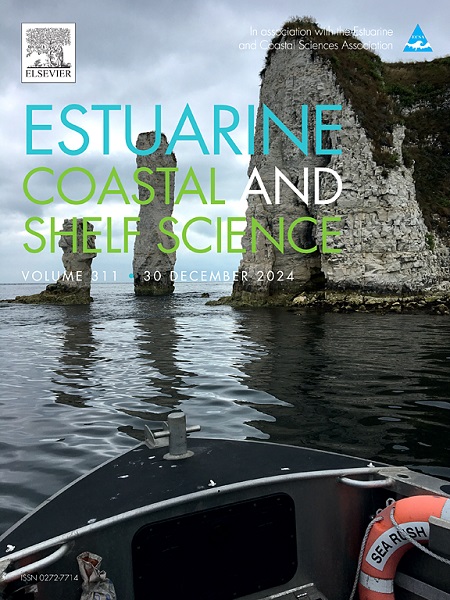A novel zooplankton-based environmental monitoring tool for coastal impacted areas: The case of the Doce River dam rupture
IF 2.6
3区 地球科学
Q1 MARINE & FRESHWATER BIOLOGY
引用次数: 0
Abstract
Zooplankton monitoring has been carried out in the Doce River region since 2015, when the Fundão mine dam ruptured and its tailings reached the coast. It is considered the biggest environmental disaster in Brazilian history. Here, we present an update on the zooplankton community scenario and introduce the novel Prevalence of Bioindicator Groups (PBG) index. It uses bioindicator taxa (Paracalanus cf parvus and Oikopleura spp) to assess inorganic pollution in the water. We measured salinity, temperature, river flow and wave energy and sampled quarterly for metal(loid) elements, suspended particulate matter, organic matter, and chlorophyll-a concentrations in the water along with zooplankton vertical sampling. Shannon diversity and Pielou evenness indexes were negatively correlated with the Doce River flow. They reached the lowest mean values during the three first wet periods of January 2019, 2020, and 2021, with significantly different values from the dry periods. PBG variation was better explained by concentrations of Cr, Co, Ni, Cu and Pb and by the percentage of organic matter. An apparent improvement in the zooplankton community was detected based on diversity, evenness and PBG values comparing the first years of monitoring (first to third) with the last years (fourth and fifth), which could be linked to the reduction of metal bioavailability in the water. It is still unclear whether this improvement represents a linear trend or a fluctuation caused by extreme local oceanographic events. Either way, PBG indicate that the environment is still far from recovering to its pre-dam rupture status and proven to be useful as a complementary tool for metal(loid) impact monitoring.

一种基于浮游动物的新型沿海受影响地区环境监测工具:以多色河大坝决堤为例
自2015年fund o矿坝破裂,尾矿涌向海岸以来,在多泽河地区开展了浮游动物监测。这被认为是巴西历史上最大的环境灾难。在此,我们介绍了浮游动物群落情景的最新进展,并介绍了新的生物指标群流行率(PBG)指数。利用生物指示类群(Paracalanus cf parvus和Oikopleura spp)评价水体无机污染。我们测量了盐度、温度、河流流量和波浪能,并每季度采样一次水中的金属元素、悬浮颗粒物、有机物和叶绿素-a浓度,同时进行浮游动物垂直采样。Shannon多样性指数和Pielou均匀度指数与多斯河流量呈负相关。在2019年1月、2020年1月和2021年1月的三个前湿期,它们的平均值最低,与干旱期的平均值有显著差异。用Cr、Co、Ni、Cu和Pb的浓度和有机质的百分比可以更好地解释PBG的变化。根据浮游动物群落的多样性、均匀性和PBG值,将监测第一年(第1年至第3年)与最后一年(第4年和第5年)进行比较,发现浮游动物群落明显改善,这可能与水中金属生物利用度降低有关。目前尚不清楚这种改善是线性趋势还是由极端的局部海洋事件引起的波动。无论哪种方式,PBG表明环境仍远未恢复到大坝破裂前的状态,并被证明是金属(loid)影响监测的补充工具。
本文章由计算机程序翻译,如有差异,请以英文原文为准。
求助全文
约1分钟内获得全文
求助全文
来源期刊
CiteScore
5.60
自引率
7.10%
发文量
374
审稿时长
9 months
期刊介绍:
Estuarine, Coastal and Shelf Science is an international multidisciplinary journal devoted to the analysis of saline water phenomena ranging from the outer edge of the continental shelf to the upper limits of the tidal zone. The journal provides a unique forum, unifying the multidisciplinary approaches to the study of the oceanography of estuaries, coastal zones, and continental shelf seas. It features original research papers, review papers and short communications treating such disciplines as zoology, botany, geology, sedimentology, physical oceanography.

 求助内容:
求助内容: 应助结果提醒方式:
应助结果提醒方式:


